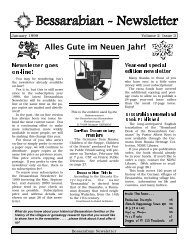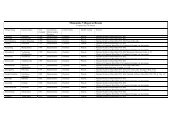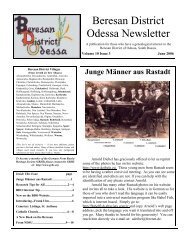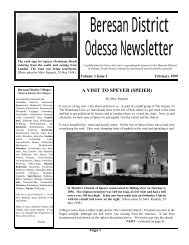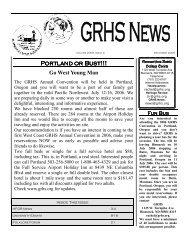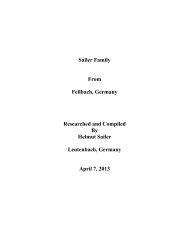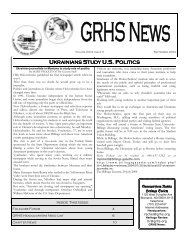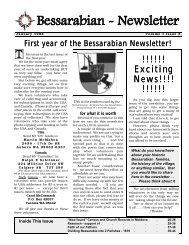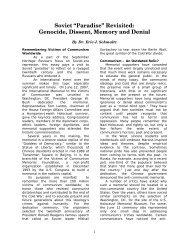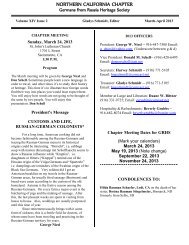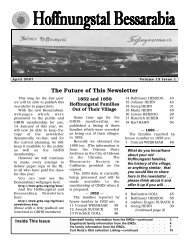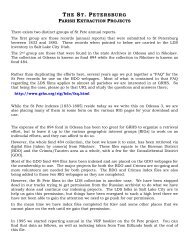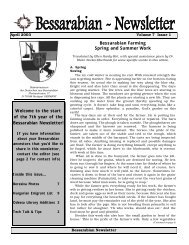Grossliebental District Odessa Newsletter - GRHS Home Page
Grossliebental District Odessa Newsletter - GRHS Home Page
Grossliebental District Odessa Newsletter - GRHS Home Page
You also want an ePaper? Increase the reach of your titles
YUMPU automatically turns print PDFs into web optimized ePapers that Google loves.
A publication for those who have a genealogical interest in the<br />
<strong>Grossliebental</strong> <strong>District</strong> of <strong>Odessa</strong>, South Russia.<br />
Volume 2 Issue 2 March 2003<br />
<strong>Grossliebental</strong><br />
<strong>District</strong> Villages<br />
(Those in bold are first villages.)<br />
Alexanderfeld (E), Alexanderhilf (E),<br />
Annental (E), Berg, Berlin, Blumenfeld (C),<br />
Bohensky (E), Buhojewka (E), Burkunowa (E),<br />
Businova (E), Chabolat (E), Eigenfeld (E),<br />
Franzfeld (C& E), Freidorf, Freudental (E),<br />
Gnadenfeld (E), <strong>Grossliebental</strong> (E),<br />
Güldendorf (E), Guss, Helenental (E),<br />
Johannesfeld (E), Josefstal (C), Kamyshovo,<br />
Karlsthal (E), Klein Liebental (C),<br />
Krassna (C), Lamsaki, Lichtenfeld (E),<br />
Lustdorf (E), Mariental (C), Martsianovka,<br />
Neuburg (E), Neu Freudental (E),<br />
Neu Liebental (C), Neu Lustdorf (E),<br />
Neu Peterstal (E), Neusatz (E),<br />
Neu Schampoly, <strong>Odessa</strong> (E), Paulstal (E),<br />
Peterstal (E), Renski, Rosenfeld (E), Scharova,<br />
Shedevri, Schönfeld (E), Schuttowa (E),<br />
Sokolovo, Sophiental (E), Wilhelmstahl (E),<br />
Wygoda (E).<br />
(This list in not all inclusive. If you have<br />
additions, please provide to the lead editor.)<br />
(E)=Evangelical (C)=Catholic<br />
Inside This Issue page<br />
Tracing Ancestors from Hungary<br />
to the Village of Alexanderhilf 1<br />
Tscherwenkaer Familien 2<br />
Kleinliebentaler Repression List 3<br />
History in Old Letters 4<br />
Lenintal Plat Map 5<br />
Sod House on Geigle <strong>Home</strong>stead 6<br />
Vision for a Chapter 8<br />
GDO AA Team 9<br />
<strong>Grossliebental</strong> <strong>District</strong><br />
<strong>Odessa</strong> <strong>Newsletter</strong><br />
Tracing Ancestors from Hungary to the<br />
Village of Alexanderhilf<br />
By Gayla Ohlhauser Gray<br />
I began the Tracing Ancestors from Hungary to Russia series with the<br />
March 2002 issue of this newsletter. The first article discussed the three<br />
phases of German migration to Hungary, included a map of the Hungarian<br />
settlements by Germans, and included information on how to find additional<br />
data on many of the Hungarian villages that our ancestors settled. The March<br />
2002 issue focused specifically on Germans who migrated from Hungary to<br />
the village of Neuburg, the July 2002 issue on Germans from Hungary to<br />
Peterstal, and the November 2002 issue on Germans from Hungary to<br />
Freudental. This issue focuses on Germans from Hungary to the village of<br />
Alexanderhilf with surnames including:<br />
BENDER, Johann and Peter<br />
BERG, Johan, Martin and Adam<br />
BI(E)BER, Jakob<br />
HUTTER, Michael and Peter<br />
KLEIN, Philipp and Reinhard<br />
KONIG, Hans and Georg<br />
KOENIG, Margaraethe<br />
KUHN, Simon<br />
LANG, Thomas<br />
LAUTENSCHLAGER, Georg, Jakob, Johann and Heinrich<br />
MOHR, Peter<br />
MOOR, Philipp<br />
NEUBAUER, Christian and Georg<br />
NEUFER(T), Georg and Konrad<br />
SCHLAFMANN, Philipp, Katharina, Georg and Margaretha<br />
UHL, Johann Friedrich<br />
The URL http://www.ieway.com/richa883/gdo/newsletters/<br />
newsletters.htm contains many more details on these families. Select<br />
<strong>Page</strong> 1<br />
(Continued on page 9)
<strong>Newsletter</strong> Line-up<br />
Lead Editor: Gayla Gray<br />
Assistant Editors: Dale Wahl,<br />
Karen Abel, Darla McNeel, and<br />
Dr. Ralph Wiseman<br />
Village Coordinators<br />
Klein Liebental<br />
Doris Dickenson<br />
14125 Janice Dr.<br />
Guerneville, CA 95446<br />
dmdickenson@juno.com<br />
Alexanderhilf, Freudental and<br />
Neu Freudental<br />
Gayla Gray<br />
1344 W. Musket Way<br />
Chandler, AZ 85248<br />
gaylagray@msn.com<br />
<strong>Grossliebental</strong><br />
Jim Helfenstein<br />
7576 SW Oleson Rd. #E5<br />
Portland, OR 97223<br />
jimscastle@attbi.com<br />
Peterstal<br />
Karen Hoffman<br />
1369 Burris Drive<br />
El Cajon, CA 92019-3574<br />
GENKH@aol.com<br />
Klein-Liebental<br />
Peter Mock Jr.<br />
Johannes-Palm Str. 9 89079<br />
Ulm GERMANY<br />
pmulm@hotmail.com<br />
Güldendorf<br />
Curt Renz<br />
1218 Wheeler St.<br />
Ames, IA 50010-4267<br />
RWheelerst@aol.com<br />
Berlin/Neu Berlin and Karlsthal<br />
Dale Wahl<br />
7370 Grevena Ave NE<br />
Bremerton WA 98311-4046<br />
dwahl@telebyte.com<br />
Alexanderhilf, <strong>Grossliebental</strong>, Neuburg,<br />
and Peterstal<br />
Elli Wise<br />
105 Meadowview Drive<br />
Frankfort, KY 40601-4017<br />
efilou792@aol.com<br />
Freudental, Helenental and<br />
Neu Freudental<br />
Dr. Ralph Wiseman<br />
1006 East 58th Street<br />
Tacoma WA 98404<br />
RJDJ4@Earthlink.net<br />
<strong>Grossliebental</strong> <strong>District</strong> <strong>Odessa</strong> <strong>Newsletter</strong> - Volume 2 Issue 2: March 2003<br />
<strong>Page</strong> 2<br />
Tscherwenkaer Familien<br />
1785-1944<br />
By Angela Hefner and Reviewed by Karen Abel<br />
Early last year I was able to borrow a copy of Angela Hefner’s selfpublished<br />
book Tscherwenka, Batschka, 1785-1944, Tscherwenkaer<br />
Familien. In it she details the results of her research into the origins of<br />
Tscherwenka families. I copied the pages of interest to me in my research<br />
of ancestors who had settled in Tscherwenka before moving on to South<br />
Russia. Part of what I copied was Ms. Hefner’s introduction. As it is<br />
written in German, Bob Berger and Betty Lang very generously answered<br />
my plea for help in translating it. Once it was translated, I was able to see<br />
that this introduction was a document that other German-Russian<br />
researchers would be interested in reading. Ms. Hefner very graciously<br />
gave her permission for the translation to be published. You can now find<br />
it online at:<br />
http://pixel.cs.vt.edu/library/villages/link/tscher.txt<br />
This document will be of particular interest to those with ancestors<br />
from Tscherwenka and other villages in Hungary. There is specific<br />
information on residents of and life in Tscherwenka. Ms. Hefner also<br />
details the method of assignment of settlers to particular villages in<br />
Hungary and the reasons why so many of them eventually left Hungary to<br />
go to South Russia.<br />
But there is also information that will appeal to any German-Russian<br />
researcher. Ms. Hefner discusses why Germans left their homeland and<br />
provides an excellent description of the journey from Germany to<br />
Hungary (which in many ways parallels the journey to South Russia).<br />
Included with the introduction are two lists: (1) the first list of<br />
Tscherwenka inhabitants from July 14, 1790, and (2) a December 31,<br />
1802, liquidations list (for loan repayment). These may be of some help to<br />
those researching Tscherwanker ancestors.<br />
Unfortunately, I do not have a copy of the entire book and cannot do<br />
look-ups of specific families. As it is now out of print, I would be most<br />
interested in hearing from anyone who has a complete copy of the book.<br />
The Beresan, Bessarabia, Brunnental, <strong>Grossliebental</strong>, Hoffnungstal<br />
Bessarabia, and Hoffnungstal <strong>Odessa</strong> newsletters have been<br />
updated on the pixel. Check them out as you never know where you<br />
might find your ancestors.<br />
http://pixel.cs.vt.edu/library/newsletters/
1. GRETZ, Theodor<br />
2. GRETZ, A.<br />
3. GRETZ<br />
4. SCHNURR, Valentin<br />
5. GRAD, Kaspar<br />
6. MOSER, Peter<br />
7. MOSER, J.<br />
8. WALDMANN, Anton<br />
9. STEIER, Pius<br />
10. HERZOG, Franz<br />
11. KLAUS, Benhard<br />
12. KEHL, Nikodemus<br />
13. KOCHER, Kaspar<br />
14. KOCHER, Georg<br />
15. MALSAM, Nikolaus<br />
16. WOLF, Alexander<br />
17. WOLF, Georg (father)<br />
18. WOLF, Georg (son)<br />
19. SCHNEIDER, Nikolaus<br />
20. *FIX, Leonhard<br />
21. MOOK, Erasimus<br />
22. HÄUSER, Johannes<br />
23. IMBERY, Johannes<br />
24. DIERINGER, Georg<br />
25. DIEHL, Franz<br />
26. GÖTZ, Kaspar<br />
27. EBERLE, Johannes<br />
28. KLEIN, Peter<br />
29. DEK, Peter<br />
30. RETNER, Joseph<br />
31. FIX, Nikodemus<br />
32. FIX, Franz<br />
<strong>Grossliebental</strong> <strong>District</strong> <strong>Odessa</strong> <strong>Newsletter</strong> - Volume 2 Issue 2: March 2003<br />
Kleinliebentaler Repression List<br />
(1937-1938)<br />
Source: Erinnerungen an die deutschen Kolonien des Grosslientaler Rayons bei <strong>Odessa</strong><br />
by Eduard Mack<br />
<strong>Page</strong> 3<br />
33. FIX, Leonhard<br />
34. FIXEL, Ignatz<br />
35. KLAUS, Jakob<br />
36. NIEDER, A.<br />
37. GÖTZ, Peter<br />
38. HARTMANN, B.<br />
39. HARTMANN, J.<br />
40. DANIEL, J.<br />
41. SCHNEIDER, A.<br />
42. WILHELM, P.<br />
43. HÄUSER, Regina<br />
44. GRETZ, Ida<br />
45. WOLF, Magdalena<br />
46. MOOK, Magdalena<br />
47. MOOK, Theresia<br />
48. KOCHER, Ida<br />
49. HÄUSER, Magdalena<br />
50. BAUMANN, Matilda<br />
51. DIERINGER, Theresia<br />
52. GÖTZ, Helena<br />
53. KLEIN, A.<br />
54. MALSAM, W.<br />
55. MALSAM<br />
56. MOSER<br />
57. WAGNER, Georg<br />
58. HUBER, Albert<br />
59. DESCHNER, Joseph<br />
* For FIX/VIX - See Hoffnungstal Bessarabia<br />
newsletter 8-3, Dec 02, page 10, for birth of Lorenz<br />
FIX * 29 Apr 1795.
Klein-Freudental<br />
28 December 1931<br />
Esteemed Staats-Anzeiger!<br />
<strong>Grossliebental</strong> <strong>District</strong> <strong>Odessa</strong> <strong>Newsletter</strong> - Volume 2 Issue 2: March 2003<br />
History in Old Letters<br />
Reprinted from Heritage Review 24: 4, December 1994 with Permission<br />
Today I want to write and send something to the dear<br />
newspaper that comes from such a long distance, for I<br />
have many friends and acquaintances in America, none of<br />
whom write about themselves to this newspaper. I have<br />
been reading this newspaper for a whole year and<br />
whenever I come in possession of a new number, I<br />
quickly scan it looking for an account by a former<br />
resident of Alt-Freudental. But up to now my searching<br />
has been in vain, and so for that reason I want to send a<br />
brief account.<br />
I once lived in Freudental but now live in Neu-<br />
Freudental. Neu-Freudental was founded four years ago,<br />
about 70 wersts (one werst = 0.67 miles) distance from<br />
Alt-Freudental. There are 45 families, all young, former<br />
citizens from the old village who settled here.<br />
Wheat harvest in our village was poor. Barley and<br />
oats yielded somewhat better but still not very good<br />
yields. Corn, potatoes, sugarbeets, sunflowers, and<br />
melons yielded very well. The weather is wintry here and<br />
it has been cold since 20 November. It is rare that we<br />
have such cold weather in November as we have had.<br />
The soil has large cracks in it, so large that a flat hand<br />
can easily be put into them. We also have had snow<br />
several times.<br />
Now I want to write something about my life. I am<br />
65 years old. In my life I have lived through more<br />
unpleasantness than through good times. I have been a<br />
widower for thirteen years. My wife’s maiden name was<br />
Entzi; she was the daughter of Johannes. Her passing was<br />
a blow to me to be left without a wife. And when I reflect<br />
on my life, I can only say that it has been precious as well<br />
as troublesome and laborious. Often the following verse<br />
comes to mind:<br />
What has been my entire condition, Was ist mein ganzes Wesen,<br />
From the time of my youth on, Von meiner Jugend an,<br />
But toil and need. Als Müh und Not gewesen,<br />
<strong>Page</strong> 4<br />
As long as I can remember Solang ich denken kann<br />
I have had on numerous mornings, Hab ich so manchen Morge,<br />
And on many dear nights, So manche liebe Nacht,<br />
With worry and with sorrow, Mit Kimmer und mit Sorgen,<br />
Conveyed these to my heart. Des Herzens zugebracht.<br />
And now when I glance towards the future, my wish<br />
is: Lord, grant a blessed end from all our miseries<br />
(distress).<br />
Now I want to inform my former village people from<br />
Freudental living across the ocean who passed away in<br />
Freudental during the past year. Daniel Oster 78 years;<br />
Gottlob Abel 77 years; and his widow Magdalena<br />
Rothenberger nee Klinger 60 years. Those from<br />
Freudental who died but were no longer living in<br />
Freudental were: Lukas Ohlhäuser 79 years; Lukas has<br />
two brothers in America Friedrich and Jakob Ohlhäuser<br />
who are my uncles. Others who died were Christian<br />
Stolz and his wife Katharina nee Losing both 72 years;<br />
Johannes Heitzmann 67 years; Johann Himmrich and his<br />
wife Regina nee Moser both 61 years; Johann Oster the<br />
former neighbor of Jakob Kresz 64 years. He too has two<br />
brothers in America namely Wilhelm and Jakob (Oster).<br />
The following died in Wygoda: Christian Heizmann<br />
76 years; Christian Moser and his wife Elizabeth nee<br />
Abel both 56 years old.<br />
The oldest male residents now live in the lower part<br />
of the village. These are: Johann Renschler, Michael<br />
Ohlhäuser, and the glazier Heiner. Upper village<br />
residents are Jakob Bohlender, Jakob Pfaff near the<br />
pond, Johann Lorenz, and Wilhelm Dick.<br />
Now that I related the most important news about my<br />
old village, I hope this will spur someone into writing<br />
about what is happening over there. Especially my<br />
nephew Johann Beckerson son of Friedrich—it has been<br />
three years since you last wrote a letter to me. At the<br />
time he was in Ruff, Washington, where he probably still<br />
lives today. I hope I will hear from him through this<br />
newspaper.<br />
(Continued on page 9)
<strong>Grossliebental</strong> <strong>District</strong> <strong>Odessa</strong> <strong>Newsletter</strong> - Volume 2 Issue 2: March 2003<br />
Lenintal Plat Map<br />
Source: Erinnerungen an die deutschen Kolonien des<br />
<strong>Grossliebental</strong>er Rayons bei <strong>Odessa</strong> by Eduard Mack<br />
<strong>Page</strong> 5
The Jakob Geigle<br />
family came to the United<br />
States in 1884 from<br />
Helenenthal, South Russia and<br />
spent the winter in Menno,<br />
Dakota territory with a sister,<br />
Katharine. In May of 1885 the<br />
Geigle's and brothers and<br />
sisters of Katherine took the<br />
train to Ispwich and then by<br />
wagon went to their new home<br />
in Campbell county. There<br />
they built a combination sod<br />
house and barn on their<br />
preempt claim (Township<br />
125 N - Range 75 W) SW<br />
<strong>Grossliebental</strong> <strong>District</strong> <strong>Odessa</strong> <strong>Newsletter</strong> - Volume 2 Issue 2: March2003<br />
quarter of Section 10. This<br />
farm was located near a lake<br />
as this was source of water for drinking and for their<br />
livestock. They filed claim to NW quarter of Section 15 as<br />
their tree claim and began in 1890 to build new farm as<br />
their homestead. The house you see in the picture began in<br />
1890 and was completed by 1893. The sod house was 50<br />
feet long and 20 feet wide and the walls were 12 feet high<br />
and 18" thick. The walls were of poured mud mixed with<br />
straw. The house was divided equally into 3 rooms. Center<br />
of the house was the kitchen and to the west was bedroom<br />
and to the east master bedroom and living room combined.<br />
The house had one window on the north side, located in<br />
center of kitchen and two small windows on south side next<br />
to entrance about 4 feet off the floor. What you see in the<br />
picture is west and south side of house. The west section<br />
had only 2 large windows and this room was a bedroom for<br />
the children. In this room was a Russian bake oven with<br />
door to oven built into wall of kitchen. It is not known<br />
when this oven was removed. The door was still there when<br />
I lived on the farm. The east room of the house had 3 large<br />
windows, 2 on the south side and 1 to east. The house was<br />
nice and cozy in winter and nice and cool in summer. The<br />
Sod House on Geigle <strong>Home</strong>stead<br />
Submitted by Herbert Geigle<br />
<strong>Page</strong> 6<br />
exterior of the house was<br />
covered with wood<br />
siding and roof was of<br />
wood shingles. There<br />
were two chimneys. The<br />
entrance was built of<br />
wood and was used in<br />
the winter time for<br />
overshoes and heavy<br />
coats, etc. Next to<br />
entrance was a cistern<br />
where rain water was<br />
collected. This was used<br />
to cool milk, butter, and<br />
cream which was needed<br />
by family for meals.<br />
Jacob Geigle sold this<br />
farm to Erwin Rau in<br />
1947. Erwin lived in this house for several years.<br />
Sometime in early 1950's the house was torn down. The<br />
cyclone<br />
cellar was located on the east side of house. A dugout of<br />
about 6 feet was with cement wall and Hebrew roof with<br />
cement sides to lead to entrance of cellar.<br />
There was an air shaft on top of the roof. The roof was<br />
covered with dirt. The floor was of dirt covered with sand.<br />
Carrots, beets, potatoes would be stored here and did not<br />
sprout until summer months. All canned vegetables, fruit,<br />
meat, lard, and eggs and cream was kept here in the cool<br />
cellar. I hated to go down there in summer time as there<br />
were salamanders and sometimes a snake. During summer<br />
months we would spend time there when a storm raged<br />
above us. This cellar was also covered up when the house<br />
was torn down. The sod summer kitchen was torn down<br />
long before my time. My Aunt Carrie would talk about it<br />
as this was the place they did all the baking, cooking,<br />
making of soap, canning, ironing, and washing of clothes.<br />
The present owner of this farm is Alan Rau, son of Erwin.<br />
This picture was taken in either 1940 or 1942 when the sons and<br />
daughters of Jacob and Katharine (Sieler) Geigle met at the<br />
homestead for a family reunion. The farm is located 11 miles north<br />
of Java, South Dakota. The homestead is located in the NE quarter<br />
of Section 15 of Blessing township in Campbell county. Front row<br />
left to right: Carrie Hirning of Burt, North Dakota; Alvina Schaefer<br />
of Tripp, South Dakota; and Rosina Borth of Gackle, North<br />
Dakota. Standing is Adam Geigle of Pollock, South Dakota and<br />
Jacob Geigle who resided on the home place. Missing from the<br />
picture is Katherina Huether of Hollywood, California.<br />
(Continued on page 10)
<strong>Grossliebental</strong> <strong>District</strong> <strong>Odessa</strong> <strong>Newsletter</strong> - Volume 2 Issue 2: March 2003<br />
Last year a few of us put our heads together hoping to<br />
start a new chapter offering features that we had found<br />
lacking elsewhere.<br />
When I first found an interest in exploring my<br />
ancestry, I wasted a lot of time by self-directing my<br />
efforts, and had missed the opportunity to get help and<br />
guidance from others. I was unaware of all of the<br />
resources available until much later. Needless to say, I<br />
was very discouraged with my lack of progress and had<br />
lost interest for a period of time.<br />
It was several years before my interest had<br />
reawakened, although the stimulus and chronology of this<br />
awakening evades me. This is when I first began learning<br />
of some of the resources that were available, and<br />
coincidentally began making a few contacts.<br />
This is when it became obvious that it would be to my<br />
advantage to get involved with one or more support<br />
groups. I then joined two national organizations and two<br />
local chapters, but still hadn’t found what I was looking<br />
for.<br />
Luckily, in the process I had met several others<br />
sharing the same basic discontent. And this then, is when<br />
we put our heads together.<br />
We were eager for a chapter that provided an<br />
emphasis on research which until now, had been sadly<br />
lacking. And with a hunger for a dynamic research<br />
oriented environment, we began discussing many ideas.<br />
From our discussion came a vision of a chapter that<br />
encouraged and actively assisted those who were<br />
researching their family history. To accomplish this we<br />
had to create the type of environment that focused its<br />
discussion on the many resources available, what to look<br />
for, how to retrieve, verify, and document the<br />
information. And finally, how to compile and produce a<br />
family book.<br />
With these features in mind, we set out to become a<br />
chapter that would actually help its members in search of<br />
their ancestry. This would require good communication, a<br />
lot of interactive voluntary help, and a library that didn’t<br />
close its doors. This may all sound good but it will require<br />
Vision for a Chapter<br />
By James Helfenstein<br />
<strong>Page</strong> 7<br />
imagination and creativity in order to develop a program<br />
that will provide the services that our members hope for,<br />
and still have a structure that stimulates cooperative<br />
activity without requiring constant effort to keep it<br />
moving. I hope that we are not asking too much.<br />
Thankfully we were granted a charter with <strong>GRHS</strong>, for<br />
our new chapter, giving us the opportunity to either<br />
succeed or fail in this goal. So far we have had four<br />
chapter meetings on a bimonthly basis, all of which were<br />
designed to aid the member in their pursuits.<br />
For our first meeting we held a book seminar. We<br />
brought most of our hard copy publications and assisted<br />
the members in their research. The next three meetings<br />
were engaged in a three-part seminar on how to produce a<br />
family book. This may seem like we had put the cart<br />
before the horse, but it provided a format to discuss the<br />
types of information, documentation, and photos that can<br />
be included. Additionally we had demonstrated the<br />
various software packages and their features that are<br />
available, and finally addressed the types and approximate<br />
cost of the different book designs.<br />
Admittedly, if I were to create a book today, it would<br />
consist of two covers and about three blank pages. I am<br />
joking of course, but though I couldn’t put a viable book<br />
together yet, I have a vision of what it will look like and<br />
of the material that I will include within it.<br />
Although we have scheduled activities for the next<br />
three meetings, it is about time that we exercise additional<br />
creativity and consider some new approaches that we can<br />
incorporate into our program.<br />
I think that it is time to put our heads together again.<br />
When we contemplate the future, and how our chapter<br />
will complement the lives of our members, we must ask,<br />
“how can we be of the most value to them?”<br />
As we review the previous meetings, we find that we<br />
have had one meeting directed to the specific needs of<br />
the member and three meetings with a classroom<br />
setting. These programs have all been extremely<br />
(Continued on page 8)
(Continued from page 7)<br />
<strong>Grossliebental</strong> <strong>District</strong> <strong>Odessa</strong> <strong>Newsletter</strong> - Volume 2 Issue 2: March 2003<br />
successful, and we can expect the next three scheduled<br />
presentations to be of equal quality. All of the topics that<br />
we have scheduled had rated high in the results of the<br />
survey conducted last year.<br />
Eventually, however, we will be faced with the<br />
dilemma of offering something new. And in doing so, we<br />
should first focus on the immediate needs of our<br />
members and try to assist them as they research their<br />
heritage. We should try to devise a program that is<br />
sensitive to their individual needs and flexible enough to<br />
respond accordingly.<br />
Hopefully as a general rule, we can avoid long tedious<br />
discussions of topics that don’t relate to individual needs.<br />
Speaking for myself as a retiree, I can assure you that I<br />
have attended innumerable meetings during my career,<br />
and can identify those that were dreaded by all. One must<br />
look around the room and focus on the eyes. When<br />
people resist blinking for fear that the eyes won’t open<br />
again, you can be assured that they would not be there if<br />
they had the flimsiest of excuses.<br />
We should consider providing the high quality lectures<br />
interspersed with working seminars where the members<br />
would actively work on their genealogy.<br />
The seminars can take several forms. The first that<br />
comes to mind would be similar to our first meeting<br />
where members each researched their own genealogy<br />
having help available from those of us that had<br />
volunteered.<br />
Another viable option is to provide a computer<br />
seminar with a computer for each member, each<br />
computer having access to the internet. We have had<br />
experience with this format just prior to the formation of<br />
our chapter. It was a resounding success. Although the<br />
members began their quest on an individual basis, it soon<br />
became evident that they were beginning to work<br />
together supporting each other’s efforts. This is the type<br />
of energy that we should provide a fertile environment<br />
for, so that it may grow.<br />
It is time to address some new ideas. How can we<br />
create interest groups that will draw the members into<br />
them and induce cooperative activity? When studying the<br />
<strong>Page</strong> 8<br />
list of villages being researched, it becomes evident that<br />
our membership falls into five regional groups. If these<br />
members begin working together at a seminar, will this<br />
stimulate them to work together between meetings to<br />
accomplish common goals? Will they help bootstrap each<br />
other along the way? Human nature suggests yes.<br />
We have created a “Virtual Library” that would be very<br />
valuable for this type of group activity. Keep in mind that<br />
its doors never close.<br />
In review of the survey taken last year, we find that the<br />
highest interest, by far, shared by the member’s was<br />
“Archive Acquisitions and Records Retrieval.” In<br />
response to these results our next meeting will focus on<br />
German translation. We hope to inspire the members to<br />
assist <strong>GRHS</strong> in their daunting task of translating the many<br />
records already in their possession. Who knows how much<br />
information, related to our personal interest, may be<br />
hiding untranslated and unindexed but well within reach?<br />
We must realize that our most valuable assets are our<br />
individual members and we should never forget to thank<br />
them for their participation. Should achievement awards<br />
be presented to the members as they make notable<br />
progress in their family research? Why not show our<br />
gratitude when they offer assistance with the archive<br />
records?<br />
As we put our heads together we should be able to<br />
develop many more ideas to make participation in our<br />
chapter more and more interesting to the members. And if<br />
we are successful, we will have changed our chapter from<br />
one that pushes its services to the user, to one in which the<br />
user pulls the services to the chapter. Then we will truly<br />
be there to serve.<br />
Let’s Continue the Vision.<br />
The Genealogical Research Support Group (GRSG) is a<br />
local chapter and also a “virtual chapter”. GRSG provides<br />
seminars and workshops in the Portland, Oregon area as well as<br />
research support to many <strong>GRHS</strong> members who live in areas<br />
where there is no local <strong>GRHS</strong> chapter. If you are interested in<br />
genealogy research, have a computer or access to the Internet,<br />
you might consider joining the GRSG chapter. To learn more<br />
about the GRSG chapter go to:<br />
http://www.grhs.com/grsg/index.html
(Continued from page 4)<br />
<strong>Grossliebental</strong> <strong>District</strong> <strong>Odessa</strong> <strong>Newsletter</strong> - Volume 2 Issue 2: March 2003<br />
I like very much to read the Staats-Anzeiger but there<br />
is only one copy that comes to our small village, and<br />
there are many more who want to read it. So it happens<br />
that I don’t get to see them all. By the time I want to<br />
borrow it someone else has already done so. (Hopefully<br />
you will find a friend who will pay for your<br />
subscription—Editor). Maybe one of my friends will be<br />
so good to send me a copy, and I want to thank him in<br />
advance if he will have it sent. I can’t afford to buy the<br />
paper, for I am without property and am impoverished.<br />
After searching I found an account in the Staats-<br />
Anzeiger about Jakob Christmann, and this pleased me<br />
very much. But I would like to know if this Jakob<br />
Christmann is the same person with whom I went to<br />
school. We were not only the same age but also born on<br />
the same day.<br />
The Christmas holidays provided for only meager<br />
gifts at our place this year, because Knecht Rupert on<br />
Pelznickel (a form of Santa Claus), as he is called where<br />
we live, has a very large rayon (territory). By the time he<br />
gets to us his big bag was empty and we had to be happy<br />
about the fact that we even got something.<br />
I am closing, greetings to all friends here and over<br />
there and the magicians.<br />
Staats-Anzeiger Friedrich Schatz<br />
9 February 1932<br />
(Continued from page 1)<br />
Hungary to Alexanderhilf. This file is not large but<br />
contains 9 pages of data for the surnames above. If you<br />
do not have access to the Internet but would like<br />
information on a specific surname, send your request to:<br />
gaylagray@msn.com or<br />
Gayla Gray<br />
1344 W. Musket Way<br />
Chandler, AZ 85248<br />
with a self-addressed stamped envelope and she will<br />
print out the information for you.<br />
Again, special thanks to Shirley Gibbard who<br />
provided translations from the Stefan Stader books and<br />
assisted me with other translations.<br />
<strong>Page</strong> 9<br />
GDO Archives Acquisition Team<br />
By Gayla Ohlhauser Gray<br />
<strong>GRHS</strong> already has an Archives Acquisition (AA)<br />
committee that has been very successful in retrieving<br />
records from the archives in old Russia/Ukraine. Working<br />
with the <strong>GRHS</strong> AA committee are specific district or<br />
village teams (Beresan, Bessarabia, Crimea, and<br />
Hoffnungstal to name a few). Each team prioritizes the<br />
records they would like to gain copies of and solicits for<br />
funds (which are tax deductible when sent to the nonprofit<br />
<strong>GRHS</strong>) through their web site, newsletter and mail<br />
list. Once the teams have enough funds to secure the<br />
records they have prioritized, they present their list to the<br />
AA committee. The AA committee ensures that there is<br />
no duplication of efforts and makes contact with the<br />
archives to verify the availability of the records and<br />
negotiate the best price. Once the records are retrieved, a<br />
copy is held at <strong>GRHS</strong> and a copy is prepared for the team.<br />
It's the teams who coordinate with the <strong>GRHS</strong><br />
Clearinghouse to translate and prepares the records for<br />
publishing/sharing.<br />
Until recently, GDO did not have an AA team. The<br />
following people have stepped up to the plate to support<br />
the GDO AA efforts: myself, James Helfenstein, Shirley<br />
Gibbard, Curt Renz, Betty Lang, and Anna Smith.<br />
There are many many GDO records available in the<br />
archives. These records are extremely important in<br />
helping us find and understand what life was like for our<br />
ancestors in Russia. The Freudental and Peterstal church<br />
books, the 1812 and 1858 census, and similar items are<br />
great examples of what is out there for us.<br />
As you all know, it costs money to retrieve records<br />
from the archives. If you would like to donate funds to<br />
help support the GDO AA records retrieval project, please<br />
send your check made out to: <strong>GRHS</strong>, 1125 West<br />
Turnpike Ave., Bismarck, North Dakota 58501. Send a<br />
note and mark on your check to make sure they know that<br />
the donation is for GDO AA. As soon as we start<br />
receiving funds, the GDO team can start prioritizing the<br />
records that we should go after. Thank you in advance for<br />
your support of the GDO AA Team Project.
<strong>Grossliebental</strong> <strong>District</strong> <strong>Odessa</strong> <strong>Newsletter</strong> - Volume 2 Issue 2: March 2003<br />
<strong>Grossliebental</strong> <strong>District</strong> <strong>Odessa</strong> <strong>Newsletter</strong><br />
This is the 2nd issue for the second year of<br />
publication. The next issue is scheduled for July 2003.<br />
Subscription rates are:<br />
USA: $4 per year<br />
Canada: $5 (only U.S. funds accepted) per year<br />
Checks/money orders (U.S. funds only) must be payable<br />
to: Gayla Gray<br />
Please send your check/money order to:<br />
Gayla Gray<br />
1344 W. Musket Way<br />
Chandler, AZ 85248-1931<br />
This newsletter is being published for those who<br />
have an interest in the villages of the <strong>Grossliebental</strong><br />
<strong>District</strong> <strong>Odessa</strong>, South Russia.<br />
Articles, ideas for articles, and improvements to the<br />
newsletter are most welcome. All submitted material<br />
should include a statement giving permission for use in<br />
the newsletter. Pictures are encouraged and welcome.<br />
This is your newsletter so please support it with pictures,<br />
articles, family history, stories, research information,<br />
etc.<br />
Every attempt is made to keep the copyright of the<br />
items carried in the newsletter as reuseable as possible.<br />
That means you have the freedom to use this data in<br />
your family work, unless we have noted otherwise.<br />
However, before using any data please examine the cited<br />
sources carefully and make sure you don’t use anything<br />
in a manner that it was not intended to be used. Using<br />
any of this data for anyone to gain a profit is not the<br />
intent of this newsletter and is prohibited.<br />
Subscription rates are set to recover material and<br />
mailing cost only. All time and most other expenses are<br />
donated by the editors and others involved in producing<br />
each issue, including the use of computers, printers, and<br />
phone lines.<br />
Feedback, comments, and suggestions should be<br />
sent to the lead editor gaylagray@msn.com or mailed to<br />
the address above.<br />
<strong>Page</strong> 10<br />
(Continued from page 6)<br />
This farm is over 100 years old and Alan and his 3 sons<br />
continue to farm there. Grandfather and Grandmother<br />
Johann Jakob & Katharine (Sieler) Geigle retired to<br />
Java in 1916. They lived on main street in a small house<br />
with barn and garden with some fruit trees. In 1923<br />
Katharine died and in 1933 Jakob became ill and came<br />
to stay with his son Jakob on the farm which he built.<br />
On June 1933 he died in the room in which he slept<br />
when he was on the farm.<br />
<strong>GRHS</strong> 2003 Convention<br />
If you have never attended a <strong>GRHS</strong><br />
Convention, you are missing out on a lot. The<br />
conventions are inspiring, motivational, and<br />
educational. There is something there for everyone.<br />
You can partake in seminars, singing, dancing,<br />
cultural events, work on your research, and/or<br />
socialize with others who are of German Russian<br />
heritage. Who knows, you might meet a cousin<br />
there you didn’t now you had.<br />
Many of the Village Coordinators are available<br />
during the convention to support you with your<br />
research. And best of all, the complete <strong>GRHS</strong><br />
library is right there at your fingertips.<br />
So Mark Your Calendar<br />
and Plan to Attend the<br />
33rd Annual <strong>GRHS</strong> Convention<br />
September 4—7, 2003<br />
Ramkota Inn<br />
Rapid City, South Dakota<br />
You’ll be glad you did!



